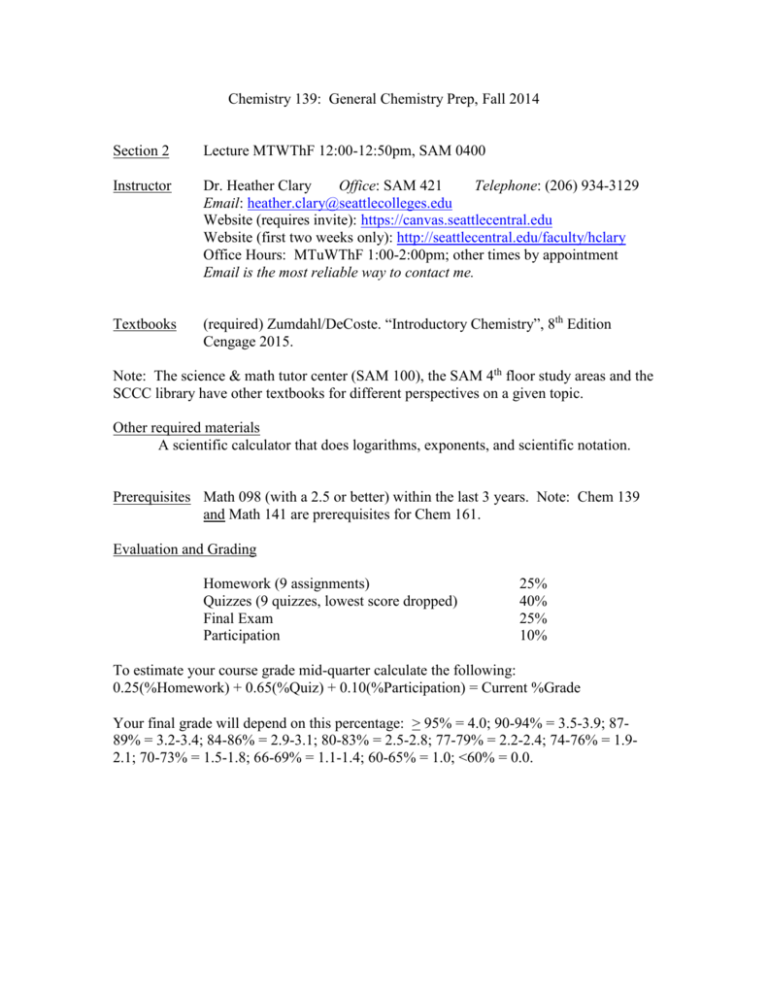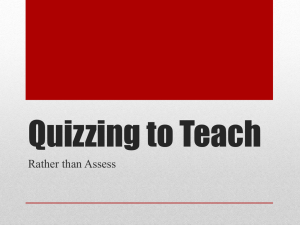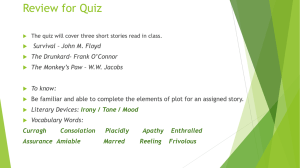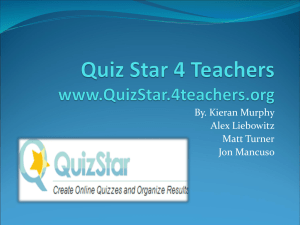Chemistry 101: General Chemistry
advertisement

Chemistry 139: General Chemistry Prep, Fall 2014 Section 2 Lecture MTWThF 12:00-12:50pm, SAM 0400 Instructor Dr. Heather Clary Office: SAM 421 Telephone: (206) 934-3129 Email: heather.clary@seattlecolleges.edu Website (requires invite): https://canvas.seattlecentral.edu Website (first two weeks only): http://seattlecentral.edu/faculty/hclary Office Hours: MTuWThF 1:00-2:00pm; other times by appointment Email is the most reliable way to contact me. Textbooks (required) Zumdahl/DeCoste. “Introductory Chemistry”, 8th Edition Cengage 2015. Note: The science & math tutor center (SAM 100), the SAM 4th floor study areas and the SCCC library have other textbooks for different perspectives on a given topic. Other required materials A scientific calculator that does logarithms, exponents, and scientific notation. Prerequisites Math 098 (with a 2.5 or better) within the last 3 years. Note: Chem 139 and Math 141 are prerequisites for Chem 161. Evaluation and Grading Homework (9 assignments) Quizzes (9 quizzes, lowest score dropped) Final Exam Participation 25% 40% 25% 10% To estimate your course grade mid-quarter calculate the following: 0.25(%Homework) + 0.65(%Quiz) + 0.10(%Participation) = Current %Grade Your final grade will depend on this percentage: > 95% = 4.0; 90-94% = 3.5-3.9; 8789% = 3.2-3.4; 84-86% = 2.9-3.1; 80-83% = 2.5-2.8; 77-79% = 2.2-2.4; 74-76% = 1.92.1; 70-73% = 1.5-1.8; 66-69% = 1.1-1.4; 60-65% = 1.0; <60% = 0.0. Homework Working through problems is the best way to understand chemistry. There will be one homework assignment due per week, generally at the end of class on Thursday. Assigned problems will be from the text, check website regularly for updated problem lists. For full credit, show all work needed to derive the answers, and offer explanations as necessary. Selected problems may be checked for correctness; however most of the points will be awarded based on completeness and timeliness. Answer keys will be available online after the homework is collected; it is your responsibility to check your answers against the key. Ask questions when your answers differ! The more problems you do, the more likely you are to succeed in this course; working additional problems beyond those assigned is highly recommended. Quizzes Nine 25-30 minute quizzes will be given over the course of the quarter; one quiz each Friday. Your lowest quiz score will be dropped. Bring your calculator; no other materials or notes will be permitted. A copy of the periodic table will be provided as needed. Any student caught cheating will receive no credit for that quiz. If you can’t make a quiz as scheduled, you must contact me before the quiz takes place if you would like to arrange a make-up. Make-ups will only be considered if documented reasons for the absence are presented, otherwise this will be the quiz you drop. Final Exam The final exam is cumulative, covering concepts from the entire quarter. In order to pass this course, you must take the final exam. The final exam will take place on Tuesday, December 9 at 10:30am. Participation Your participation score is based on attendance and effort displayed during the class. Participation in group exercises is expected. About once a week worksheets (available in class and online) will be distributed; these are to be worked on in groups of two or more students, and one completed worksheet per group (don’t forget anyone’s name!) will be turned in for participation credit after we discuss the problems in class. CHEM& 139 Course-Level Student Learning Outcomes Student Learning Outcomes After successful completion of this course, students will be able to do the following: 1. GENERAL SCIENCE AND MICROSCALE Apply the scientific method and use empirical data and observations to construct a sound scientific explanation. Distinguish between macroscopic observables and the underlying microscopic properties of matter by interpreting and representing matter using molecular-level drawings. 2. CHEMICAL PROBLEM SOLVING Demonstrate strong problem-solving skills that are supported by basic algebraic and numeracy skills. Demonstrate fluency in chemical vocabulary and symbolic representation. Use measurable quantities of matter to determine physical and chemical properties. Use stoichiometric calculations to predict quantities. 3. ATOMS, MOLECULES AND IONS Describe the general structure of an atom. Explain the historical development of the atomic theory and the evolution of the current modern atomic model. Explain the relationship between the position of an element in the periodic table and its physical and chemical properties, including periodic trends. Describe the differences in the structure and properties of substances based on different types and models of bonding. 4. STATES OF MATTER: GASES, LIQUIDS AND SOLIDS Compare and contrast the properties of the three states of matter. Use kinetic-molecular theory to explain ideal gas behavior. Describe intermolecular forces and chemical bonds and how they influence physical and chemical properties and phase transitions. 5. PHYSICAL CHANGES AND CHEMICAL REACTIONS Recognize and describe changes in heat and temperature associated with physical and chemical changes. Classify and balance chemical reactions and predict products for different types of reactions. Apply the properties of ionic and molecular substances in aqueous solution to describe systems and predict behavior. Tentative Course Schedule (changes will be announced in class) Week 1 Dates Sept. 22-26 Reading: Chapter 1: Chemistry: An Introduction Chapter 2: Measurements and Calculations Chapter 3: Matter Chapter 10: Energy Chapter 4: Chemical Foundations: Elements, Atoms, and Ions Chapter 11: Modern Atomic Theory Chapter 11 continued Chapter 5: Nomenclature Chapter 5 continued Chapter 12: Chemical Bonding Chapter 8: Chemical Composition Chapter 6: Chemical Reactions: An Introduction Chapter 7: Reactions in Aqueous Solutions On Friday No quiz 2 Sept. 29-Oct. 3 3 Oct. 6-10 4 Oct. 13-17 5 Oct. 20-24 6 Oct 27- 31 7 Nov. 3-7 8 Nov. 10-14 (no class Tues) Nov. 17-21 Chapter 18: Oxidation-Reduction Reactions (sections 18.1-18.4) Quiz 7 Chapter 9: Chemical Quantities Quiz 8 Chapter 15: Solutions No quiz 11 Nov 24-26 (no class ThF) Dec. 1-5 Quiz 9 (Thurs) 12 Dec. 9 Chapter 15 continued Chapter 16: Acids and Bases Final Exam: Tues. December 9th, 10:30am 9 10 Course accommodation: If you have any special circumstances requiring course accommodation, please see me as soon as possible so that we can make suitable arrangements in advance. In this course(as in all courses at Seattle Central) all students will be granted an equal opportunity to learn and succeed, regardless of race, class, gender, religion, ethnic origin, nationality, sexual orientation or physical disability. If you have any concerns pertaining to these issues, please feel free to speak to the instructor or department dean. Students with documented disabilities requesting class accommodations, requiring special arrangements in case of building evacuation, or have emergency medical information the instructor should know about are asked to contact the disability support services office (DSS) in Rm. 1112. Once the disability is verified with DSS you will be given a letter of accommodation to be handed to your instructor. Quiz 1 Quiz 2 Quiz 3 Quiz 4 Quiz 5 Quiz 6 CHEM 139: Introduction to General Chemistry Name Name you’d like to be called (if different) Why are you taking Chemistry 139? What do you hope to get out of the class (besides a 2.0+ so you can take Chemistry 161)? What other math and science classes have you taken? Any chemistry? What do you think will be the most difficult part of the course? Is there anything else you think is important that I know about you?







